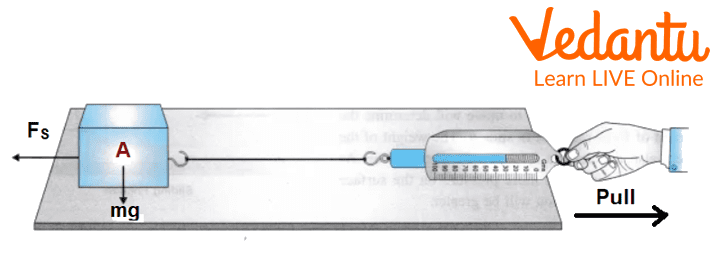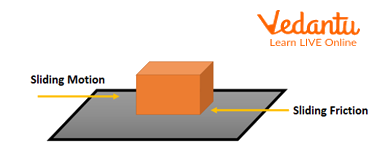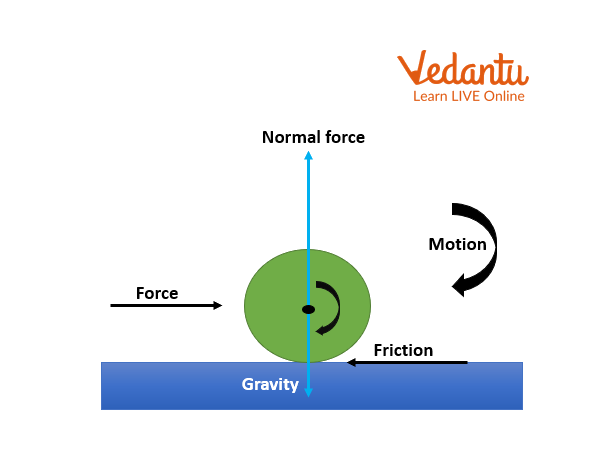




To Determine the Relationship Between Friction and Force
Introduction
When two surfaces move across one another or attempt to move across one another, friction is a force that is produced and is directly proportional to the weight of the body. The motion is always opposed by friction when the two surfaces come in contact with each other and prevents an object from moving. The frictional force keeps our feet firmly planted on the ground as we walk on the ground or a floor as well as when we run on a surface.
Table of Content
Aim
Theory
Procedure
Observations
Results
Aim
With a spring balance, creating a relationship between the weight of a rectangular wooden block lying horizontally and the least amount of force necessary to simply move it.
Apparatus Required
A spring balance
a bench
a wooden slab with slots of weights
a string
slotted weights
Theory
Every time a force is applied, frictional force always operates in the opposite direction. As more power is exerted on the wooden block to be moved, more friction is created to keep it balanced. This is an indication of static friction or friction that occurs when an object is at rest.

Experimental Demonstration of the Static Friction
However, there is a limit to how much the force of friction can grow. When the applied force reaches this threshold, the object starts to move. The limiting force of friction, also known as limiting friction, is the greatest amount of force of friction that acts between two solid surfaces right before an object begins to move. The weight of the thing has a direct relationship to the force.
Procedure
Find the spring balance's range and least count.
Using a spring balance, measure the wooden block's weight.
As indicated, place a wooden block on the horizontal surface of the setup and attach it to a spring balance.
Check the spring balance's pointer.
Now pull the spring balance to exert a slight strain on the wooden block. Increase the force gradually until the block starts to slide.
Take note of the spring balance's reading.
Repeat the experiment using a wooden block that is 50 g heavier each time, and note your findings.
Observations
The spring balance's operating range =
The least count of spring balance =
Mass of the hook-shaped wooden block =
Value of the gravitational acceleration g =
The spring balance's least count, = 10 g
Mass of the hook-shaped wooden block, R= 50 g
Observation Table
Plot a graph between the spring balance reading, F on the 'y' axis, and the weight of the wooden block, W, on the x-axis. A straight line will form.
Results
It was found that the force required to be increased as the block's weight did as well.
\[\dfrac{F}{W}\] is a constant ratio.
The maximal force needed to simply move the block is precisely proportional to the weight of the block, as seen by the constant \[\dfrac{F}{W}\] ratio and the straight-line graph.
Precautions
As soon as the wooden block begins to move, it is important to take note of the reading in spring balance.
The horizontal surface needs to be dry and clean.
The wall or any other surface should not be touched by the spring balance.
When tugging the string, the amount of force that is given to the wooden block should be raised gradually and gently.
The string must not extend further.
When applying force to the block, the string must remain horizontal.
Lab Manual Questions
1. Why are the wooden block you are using, and the thread used to move it both kept horizontal?
Ans: The body is dragged horizontally because we must slide it across the surface to get the frictional forces.
2. In which direction does the frictional force affect the block?
Ans: The direction of the block's motion is opposed by the force of friction.
3. How does adding grease or oil between two surfaces in contact influence the limiting friction between them?
Ans: Fluids are applied to a surface, which smooths it out by reducing friction and the force needed to move an object.
4. What is the meaning of 1 gwt measured in your experiment?
Ans: 1 gwt is defined as the force exerted by the mass of 1 gm due to the gravity, which is basically given as mg and equals 0.098 N.
Viva Questions
1. What is the SI unit of friction?
Ans: Newton (N).
2. Why don't wooden blocks move when they are first placed?
Ans: Due to the static friction, the wooden block does not move on the surface and only moves when a force greater than the static friction will be applied on the wooden block.
3. Why do wooden blocks begin to move after receiving a certain level of force?
Ans: Wooden pieces begin to move once when the applied force exceeds the limit of the static friction force.
4. What Newtonian law does friction comply with?
Ans: Third law of Newton (Law of action and reaction).
5. Why is it advised to clean the tables before conducting experiments?
Ans: Because of the dust present on the table surface which increases the friction of the surface.
6. Why do we refer to friction as an adjustable force?
Ans: Friction is zero when no force is applied to the item. The force of static friction is always equal to the applied force until the block starts moving, therefore as the applied force grows, friction correspondingly increases. Static friction thus adjusts itself in the direction opposite to the applied force.
7. Why are the bodies of cars, planes, and launch vehicles for spacecraft made in a streamlined shape?
Ans: They are specifically shaped in a streamlined manner to reduce the impact of air friction and therefore the efficiency of operation increases.
8. Why does moving a heavier object involve more effort than moving a lighter object?
Ans: Normal reaction force 'N' also rises for a heavy body. As a result, frictional force grows. Consequently, more force is applied.
9. Why are luggage bags equipped with rollers?
Ans: Since the sliding friction is greater in magnitude as compared to the rolling friction and therefore to pull the heavier bags they are equipped with the rollers.

Sliding Motion

Rolling Friction
10. What are the variables that determine how much force is needed to simply move over the surface of a body while another surface is in contact?
Ans: It depends on the type of material used for the surfaces coming into contact as well as how smooth or rough those surfaces are.
Practical-Based Questions
1. A table is being pushed downward by a block resting on it. This force's response is
Earth’s force on the block
The tension on the block caused by the table
Earth’s force on table
The block's force on Earth
Ans: B) The tension on the block caused by the table
2. The “action” force remains in effect despite the “reaction” force because
The force of the action exceeds that of the reaction.
All are moving in the same direction
They have an impact on the two various bodies in contact.
Once the action force is gone, the reaction force only exists.
Ans: C) They have an impact on the two various bodies in contact.
3. On a horizontal surface, an object travelling to the right is subjected to a force F that is greater than the maximum force of static friction. Then
There must be a constant rate of motion for the object.
Force acts in the opposite direction from the friction force.
The object must be moving more quickly.
The object must be slowing down.
Ans: B) Force acts in the opposite direction from the friction force.
4. The table's surface is horizontal, and a wooden block is laying there. The forces affecting this wooden block are
Movement on the table's surface
Reaction happening on the wooden block
Motion on the table's surface and a reaction on the wooden block
None of the above
Ans: C) Motion on the table’s surface and a reaction on the wooden block
5. Frictional force acting on an object resting on a rough surface, will be
Static friction
Kinetic friction
Rolling friction
Sliding friction
Ans: A) Static friction
6. How much force must be used in order to move an object at a constant speed?
No force is necessary.
Force must be greater than the force of friction.
Force must be smaller than the force of friction.
Just enough force to equal the frictional force.
Ans: B) Force must be greater than the force of friction
7. When an object is subject to a balanced set of forces, then
At rest
Moving.
Must not be speeding up.
None of the above
Ans: C) Must not be speeding up.
8. Fish's streamlined bodies make it easier for them to
easily swim.
lessen the friction
increase the friction.
Both A and B
Ans: B) Both A and B
9. On ice, skating is simple, but moving on concrete is challenging because its coefficient of friction is
higher on ice rather than concrete
higher on concrete rather than ice.
similar in both.
distinct from an usual reaction
Ans: B) Higher on concrete rather than ice
10. The spring balance that is used to determine the least amount of force required to simply slide a wooden block has a least count of 1 gwt. what will be the number of divisions between its 50 gwt and 60 gwt marks?
60
20
10
50
Ans: C) 10
Conclusion
A force known as friction prevents relative motion between surfaces that are in touch. One of the more basic features of friction is that it always runs parallel to the surfaces with which it makes contact and opposes any motion or attempted motion of the systems with respect to one another. From this article, we can understand the causes affecting friction, types of friction with some examples.
FAQs on Relationship Between Weight of a Body and Force
1. What is the fundamental relationship between the weight of a body and the force of gravity for the CBSE Class 9 exam?
The weight of a body is the force with which it is attracted towards the centre of the Earth. Essentially, weight is the specific name given to the gravitational force exerted by a large celestial body like Earth on an object. This relationship is a direct application of Newton's Second Law of Motion, F = ma, where the acceleration 'a' is the acceleration due to gravity, 'g'.
2. What are the key differences between mass and weight that are important for exams?
For the CBSE 2025-26 exams, clearly differentiating between mass and weight is crucial, often appearing in 2 or 3-mark questions. The main differences are:
- Definition: Mass is the measure of matter in an object, while weight is the force of gravity acting on that object's mass.
- Constancy: An object's mass is constant anywhere in the universe. Its weight, however, changes depending on the local acceleration due to gravity (g).
- SI Unit: The SI unit for mass is the kilogram (kg). The SI unit for weight, being a force, is the newton (N).
- Zero Value: Mass can never be zero. Weight can be zero if the object is in a region with no gravitational pull, such as deep space.
3. How do you calculate the weight of an object? State the formula and SI units required for a numerical question.
The weight of an object is calculated by multiplying its mass by the local acceleration due to gravity. The formula is: W = m × g. Here, 'W' is the weight in newtons (N), 'm' is the mass in kilograms (kg), and 'g' is the acceleration due to gravity in metres per second squared (m/s²). The SI unit for weight is the newton (N).
4. Explain why an object's weight is different on the Earth and the Moon, even though its mass is the same.
An object's mass is an intrinsic property representing the amount of matter it contains, so it remains constant regardless of location. In contrast, weight is the gravitational force exerted on that mass (W = mg). The acceleration due to gravity (g) depends on the mass and radius of the celestial body. The Moon is significantly smaller and less massive than Earth, resulting in a much weaker gravitational pull. The value of 'g' on the Moon is approximately 1/6th of the value of 'g' on Earth. Consequently, an object on the Moon weighs only about one-sixth of what it weighs on Earth.
5. An object has a mass of 10 kg on the surface of the Earth. What is its weight? (Take g = 9.8 m/s²)
This is a frequently asked type of numerical problem. To find the weight, we use the standard formula W = m × g.
Given:
- Mass (m) = 10 kg
- Acceleration due to gravity (g) = 9.8 m/s²
Calculation:
W = 10 kg × 9.8 m/s²
W = 98 N
Therefore, the weight of the object on Earth is 98 newtons.
6. If weight is just a type of force, why do we use a special term for it instead of always calling it 'gravitational force'?
While weight is fundamentally a gravitational force, the term 'weight' is used for a specific, common context: the gravitational force exerted by a large celestial body (like a planet or moon) on an object near its surface. The term 'gravitational force' is more general and applies to the attraction between any two objects with mass, such as the force between the Earth and the Sun. Using the term 'weight' provides a clear and practical shorthand in physics and engineering when dealing with objects on Earth or other planets.
7. Are astronauts in an orbiting satellite truly weightless? Explain this important concept.
This is a common misconception. Astronauts in orbit are not truly weightless because Earth's gravity is still quite strong at their altitude (about 90% of the surface value). They experience a sensation of weightlessness because both they and their spacecraft are in a constant state of free fall around the Earth. Since everything is accelerating towards Earth at the same rate, they don't press against the satellite's interior, which creates the illusion of zero weight. Their true weight (the gravitational force) is still acting on them, providing the necessary centripetal force to keep them in orbit.
8. What is the relationship between buoyant force and the weight of a body when it is floating?
According to Archimedes' principle, a critical concept for exams, an object floats when the upward buoyant force exerted on it by the fluid is exactly equal to its own weight. A floating object displaces just enough fluid so that the weight of the displaced fluid equals the entire weight of the object. This creates a state of equilibrium where the downward force of gravity (weight) is perfectly balanced by the upward push of the fluid (buoyancy).
9. Could an object have mass but zero weight? Under what conditions could this happen?
Yes, an object can have mass but exhibit zero weight. This occurs when the acceleration due to gravity (g) is zero. According to the formula W = mg, if g = 0, then W will also be zero, regardless of the mass. This condition would be met in deep space, far from the gravitational influence of any planet, star, or other massive body. The object's mass would be unchanged, but without a gravitational field to act upon it, it would have no weight.





























